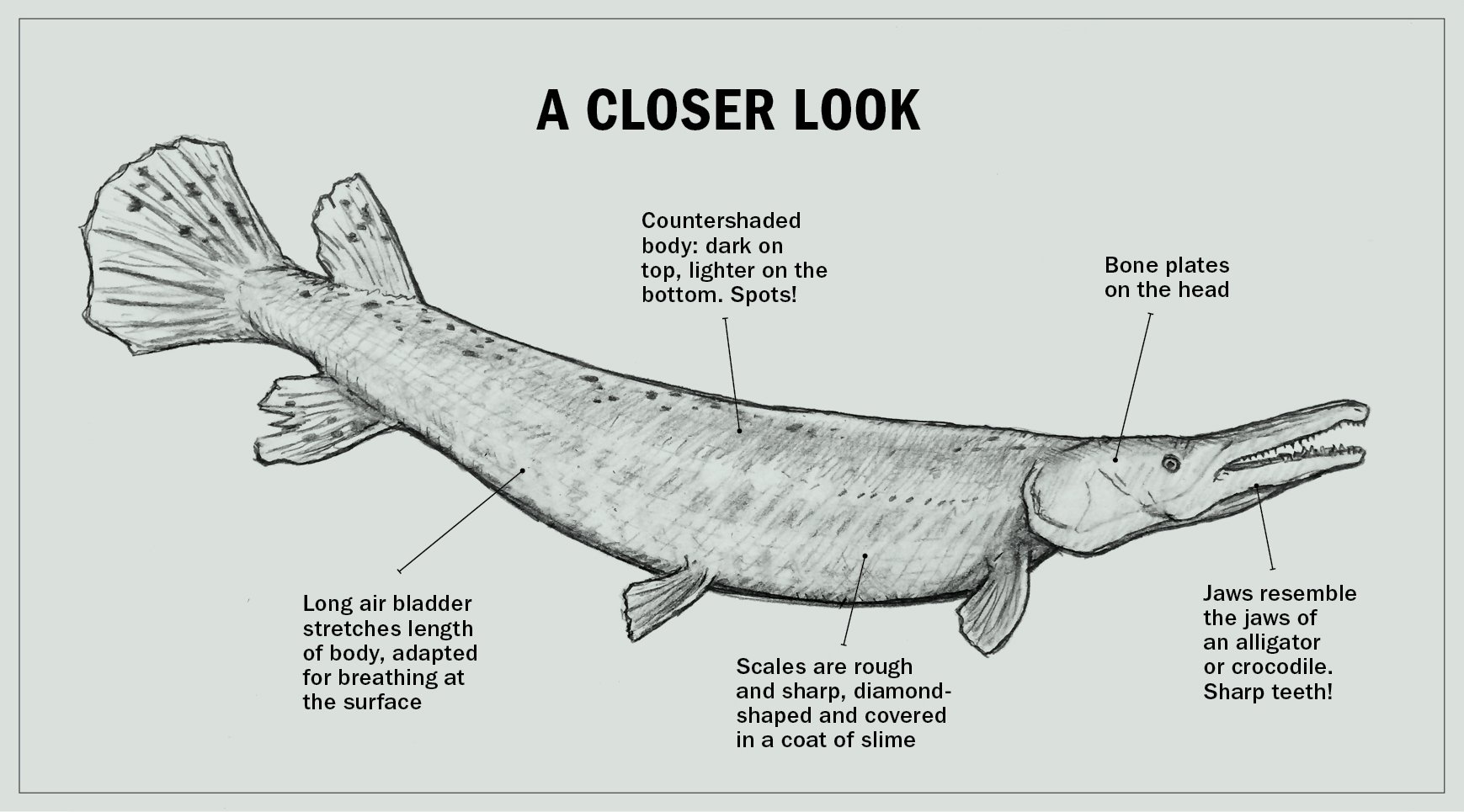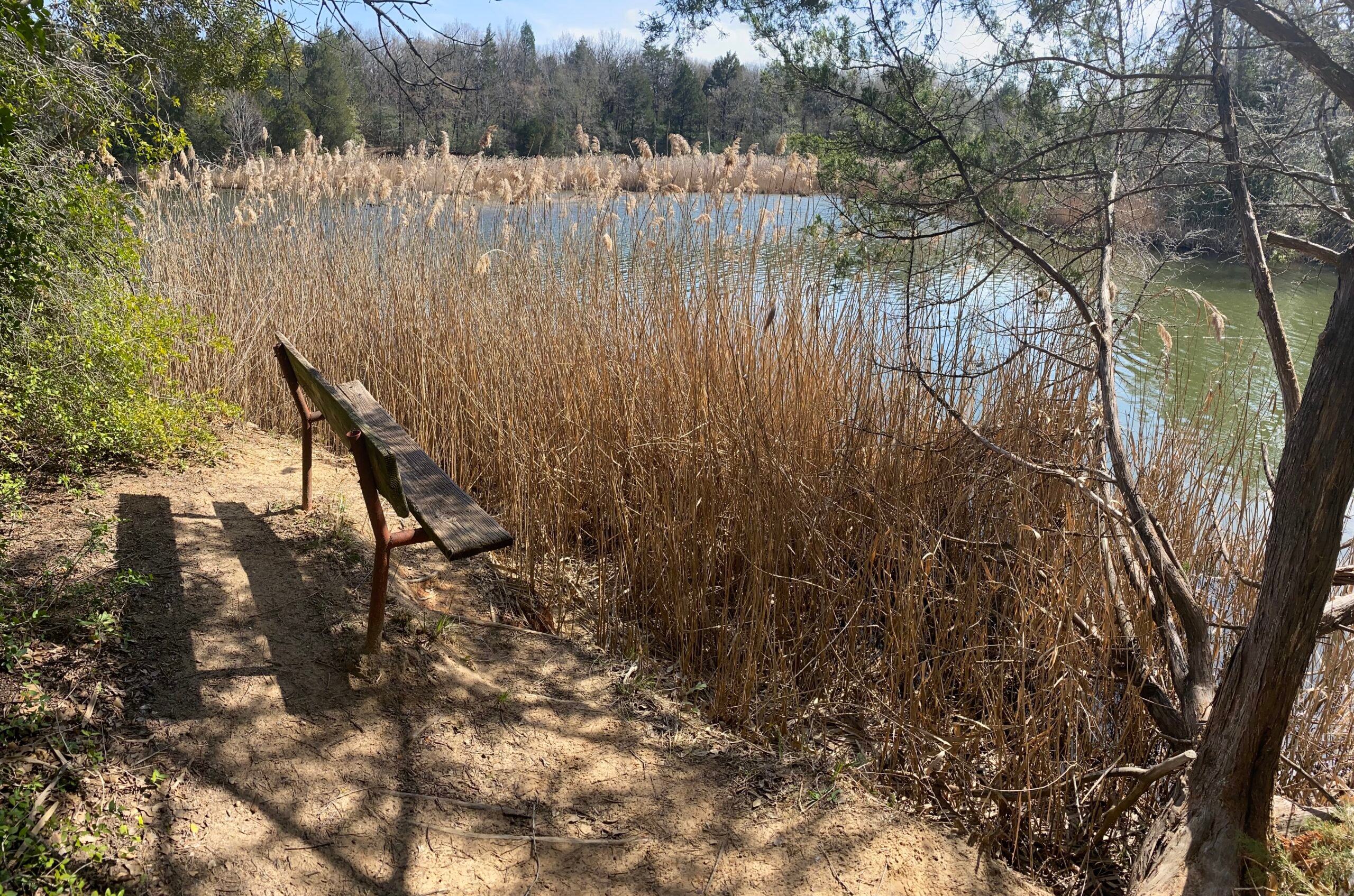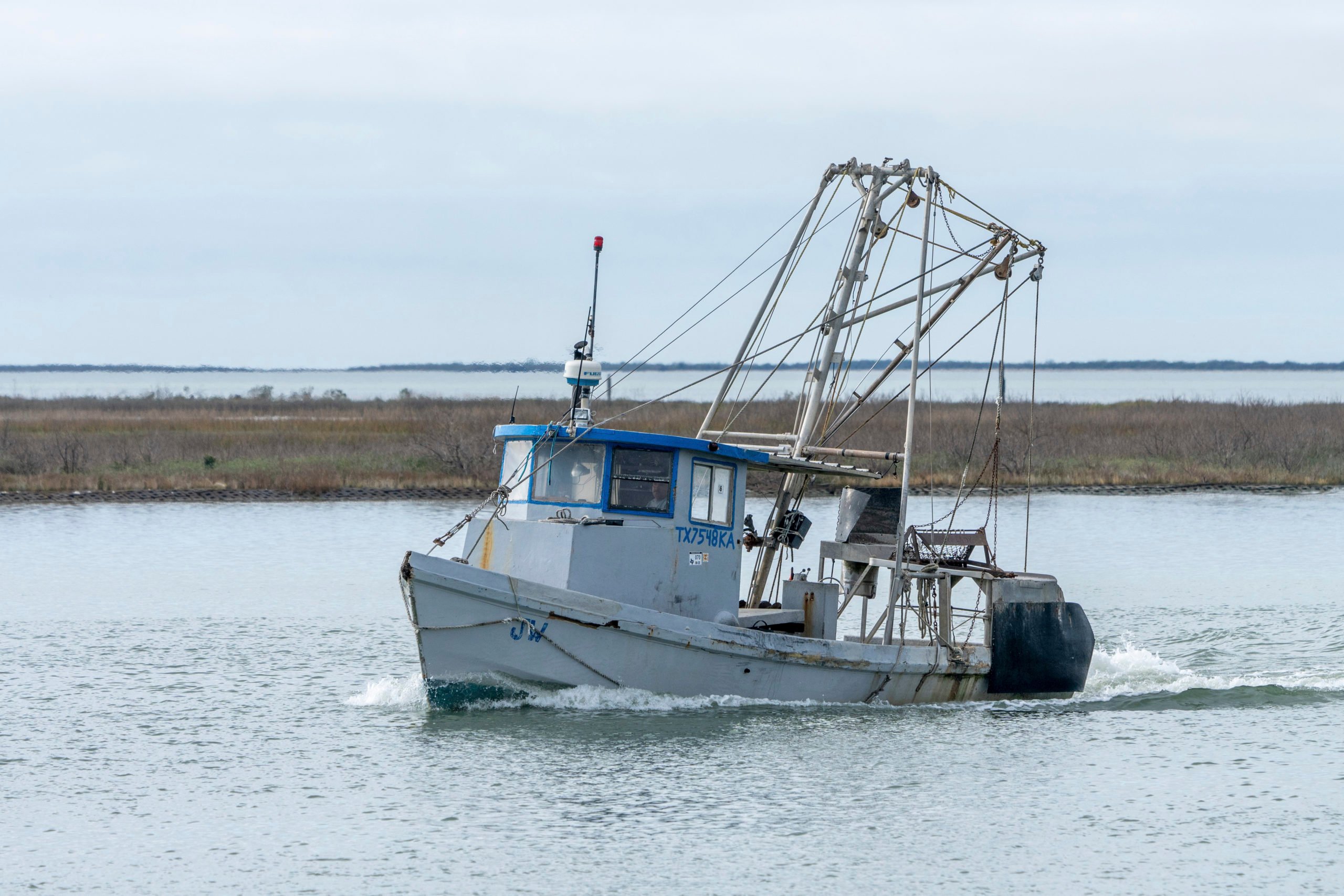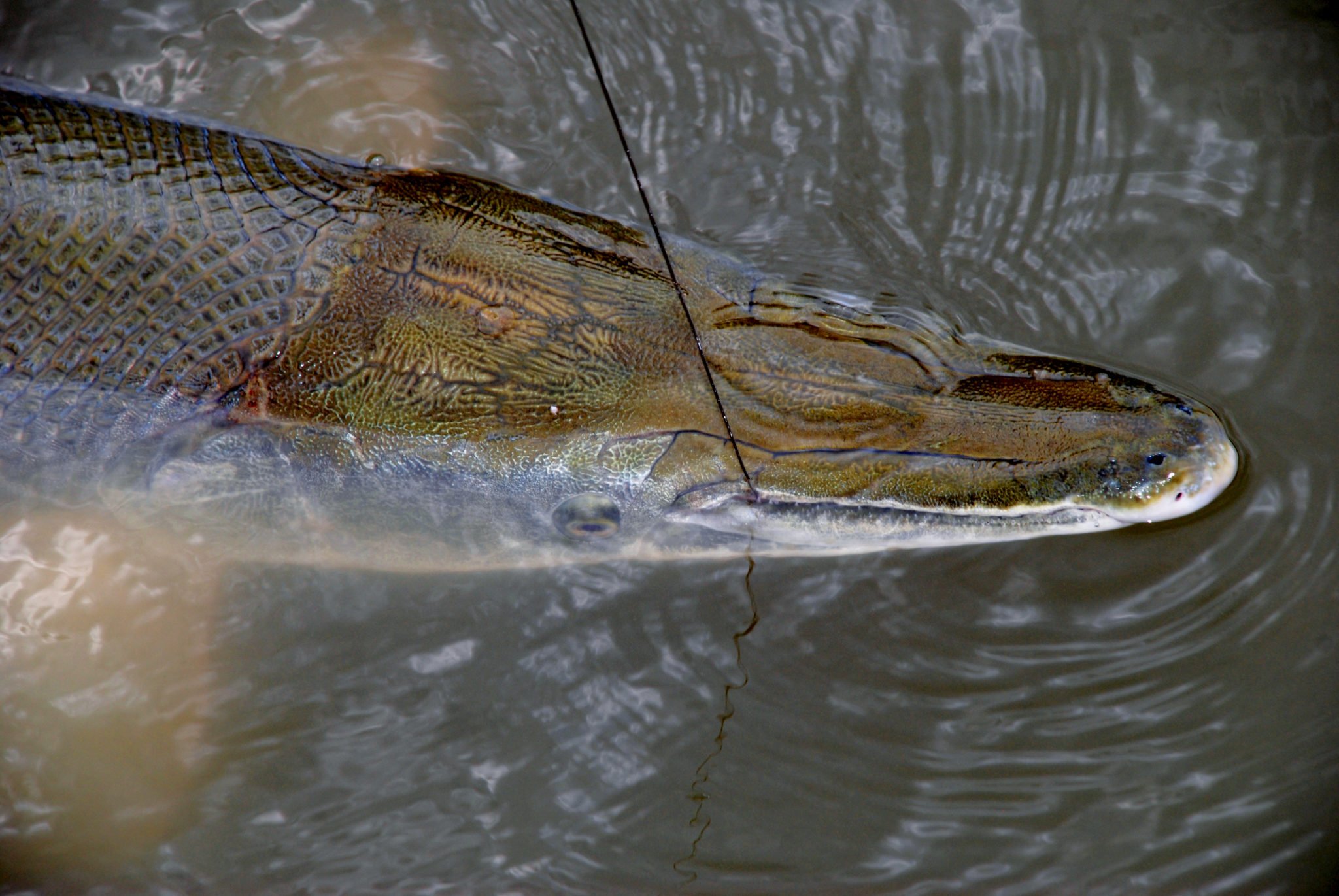
In Texas, One of the World’s Oldest, Weirdest Fish Finally Gets Its Due
Long considered “trash fish,” alligator gar have patrolled Texas rivers for millions of years. Now this living fossil may finally be getting its due.

A version of this story ran in the October 2018 issue.
When Dan Daugherty saw the nets bobbing, he gunned the outboard motor, swinging the boat around in the current and bringing it up alongside the disturbance. His coworker Travis Waldrep hurriedly cleared gear away from the bow, knelt and plunged his hands in the brown waters of the Brazos River. For a moment he grappled with something beneath the surface. The fish arched in the net as Waldrep pulled it up, its spotted fins flaring in panic. “Gar,” he called to Dan over his shoulder. “Looks like an alligator.”
It did look something like an alligator: torpedo-shaped, armor-plated and glistening, with broad, toothy jaws clamped on the offending net fibers. At 4 1/2 feet, it was at the smaller end for an alligator gar, yet still longer than any other species in the river. Its powerful thrashing rang like a fist against the metal hull.
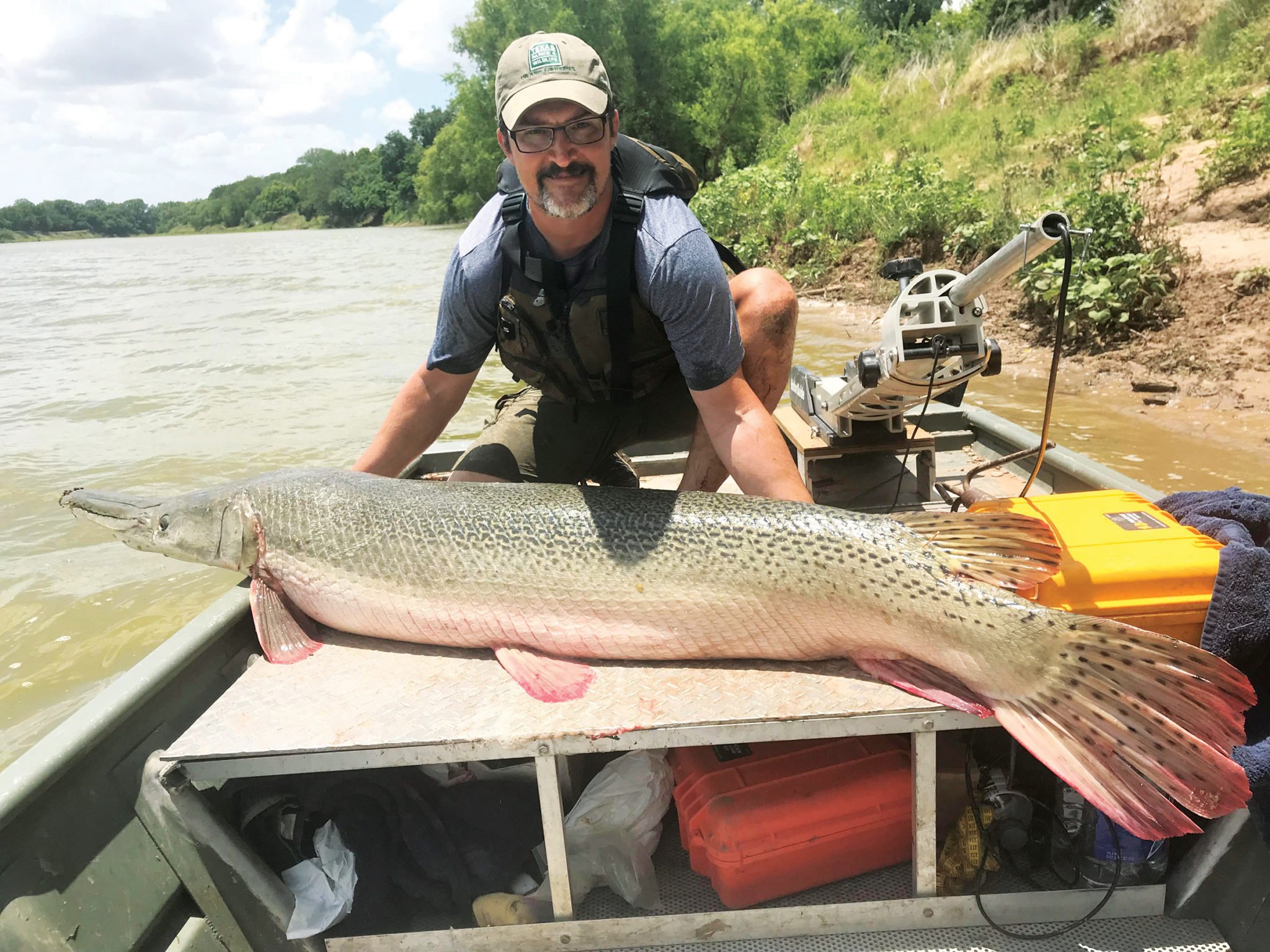
“This is why we’ve got the gloves,” Daugherty said. Waldrep crouched beside him, cutting the netting away. “I got whacked yesterday in the shin; he got whacked in the knee. Everything on them is either sharp or bony, so if you’re not paying attention there’s a high likelihood you’ll get hit, cut or poked. But they’re not going for you. It’s just a byproduct of handling them.”
Daugherty handles a lot of gar these days. A research biologist with Texas Parks and Wildlife’s Heart of the Hills Fisheries Science Center, he’s part of a monitoring program aimed at studying and managing a fish that, until recently, many fishermen wanted to see exterminated. But within the last decade, a shift has taken place. Once considered barely worthy of attention, alligator gar are becoming charismatic stars, sought after by fishermen, TV producers and biologists. For one of the oldest fish in the world, that change can’t come a moment too soon.
Millions of years before the arrival of modern mammals or birds, gar patrolled the swampy rivers of America. According to Solomon David, an ichthyologist at Nicholls State University in Louisiana, the gar family originated 157 million years ago in the Late Jurassic period and spread to every continent save Australia and Antarctica. The mass extinction at the end of the Mesozoic Era and the climatic roller coaster that followed dented their fortunes, but did not destroy them. While no species ever stops evolving, the gar we have today still look much like those of that distant epoch. Hidden within their archaic bodies is a suite of adaptations that have carried them down the millennia: spiral guts that wring the maximum nutrition out of kills, a surprising comfort with brackish water, and — most usefully — the ability to gulp fresh air. “They can survive even in water that’s really hot and low in oxygen, which would drive out other species,” David said. “That’s given them a competitive edge in some of those habitats.”
Seven species of that venerable family remain, all confined to North America. Of them, the alligator gar is among the oldest and easily the largest, with males settling in at a maximum of 5 feet and females growing to more than 8 feet and 300 pounds, making them the second-biggest North American fish. (Only the similarly old lake sturgeon is larger.) They’re tough and efficient predators, and look it. Their powerful jaws contain two rows of sharp teeth, and their bodies are covered in scales of armored chain mail and thick slime. Daugherty’s dissections of their stomachs have revealed a diet largely of fish like crappies and buffalo, waterfowl and the rare swimming snake or rodent. Given their way, he says, they’d take no notice of people at all.
Yet the gar’s fearsome appearance made it a convenient scapegoat for anglers. Alligator gar were actively persecuted throughout the 20th century, Daugherty said, dismissed as “trash fish” that damaged nets and devoured game fish. Biologists and resource managers recommended culling them; fishermen shot them with bows, clubbed them with paddles and threw their carcasses up on the bank to rot. The species, which had ranged as far up the Mississippi drainage as Southern Illinois, began to disappear in the early 20th century, pushed deeper into the swampy rivers and brackish bayous of the South. By the 21st century, only Texas and Louisiana had stable populations, and even there the gar had no legal protection, with people free to catch as many as they liked.
For a time, Bubba Bedre was one of those people. Growing up hunting and fishing along the Trinity River, he found himself fascinated by alligator gar, by their strange armored bodies and sheer size. At the time, he said, folklore had it that gar were more dangerous than the most aggressive shark, that they decimated game fish populations. But they were also big, impressive fish, and a popular target for bowfishers. In the early 2000s, a couple of Bedre’s guide friends kicked him a client — Johnny Morris, owner of Bass Pro Shop — and they ended up shooting an 8-foot-4-inch fish, the longest ever officially recorded at the time. (It’s now mounted in the flagship Bass Pro Shop in Springfield, Missouri.) In 2007, Bedre started his own business, Garzilla Guide Service. That was also the year he landed what proved to be a particularly important assignment: River Monsters, an Animal Planet documentary show about fish with fearsome reputations.
While Bedre was traditionally a bowfisher, he says, the producers wanted him to help catch a gar on rod and reel — and to release it alive. More than 1 million viewers watched the show’s premiere in 2009, the audience growing with each episode. Bedre began fielding calls from anglers throughout the United States and from further afield: Canada, Australia, Russia, Japan and all over Europe. After transferring from bowfishing gar to catch-and-release, he found that his business only grew. “At one point I was filming probably four or five shows a year for different countries, and I probably been aired all over the world,” he said. “There’s so many I can’t name ’em all. And I seen that there’s no reason to be shooting and killing something that’s so big and so old. Of course, you’re making money off it too. Why you want to kill something you make money off of? It just don’t make sense.”
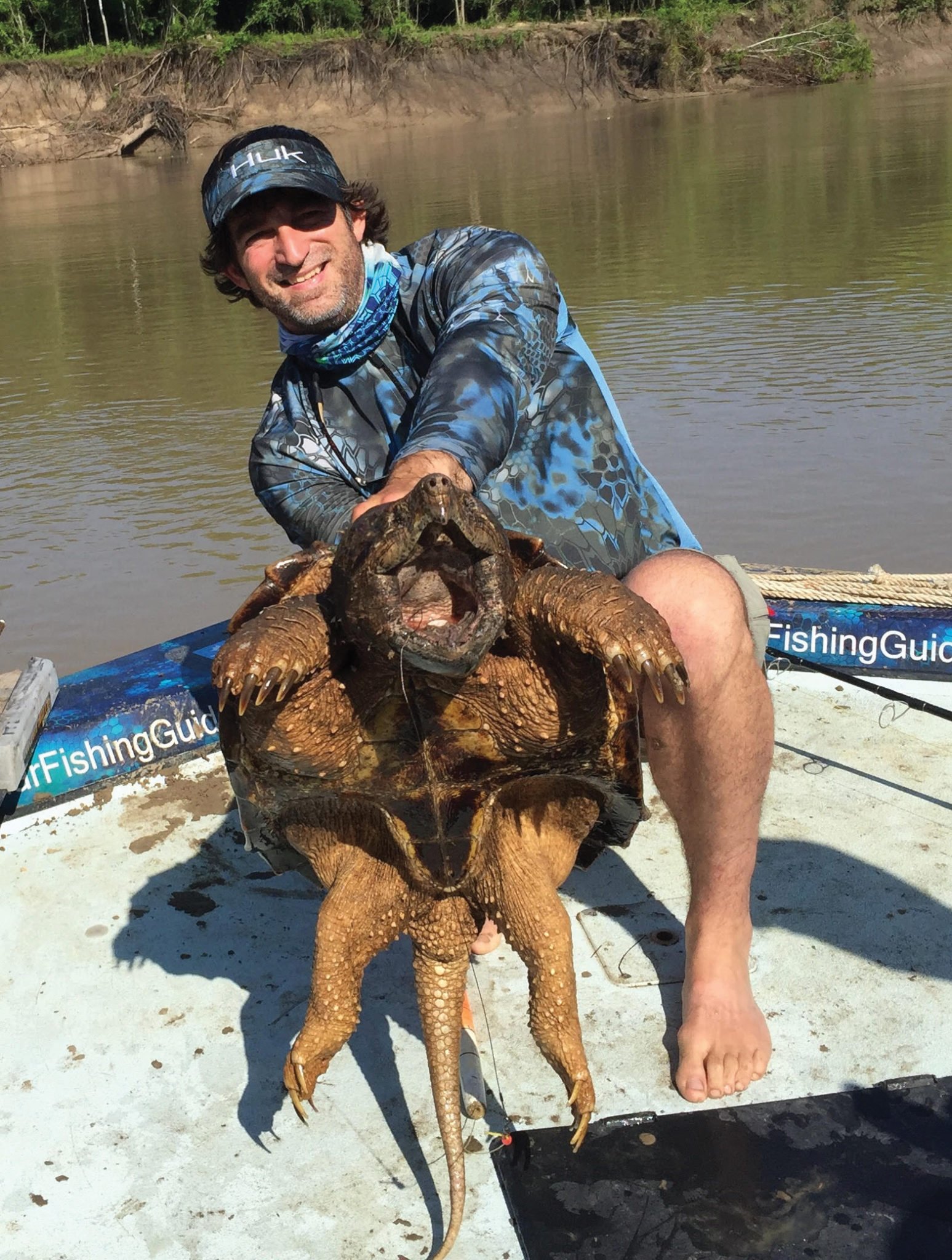
That was around the time Texas officials were beginning to look on gar more kindly, Daugherty said. It had become clear that nobody actually knew much about the fish: what they ate, how often they spawned, how they moved through the river systems. “If you did a literature search for largemouth bass at the time,” Daugherty said, “I recall there being over 20,000 peer-reviewed publications, and finding about four for alligator gar.”
In 2007, the Texas Parks and Wildlife Department (TPWD) partnered with anglers on a monitoring program that aimed to discover more about how the fish lived and bred. There were some hiccups at first, Daugherty recalled: They found that gar — which largely breathe air during the summer, when the waters grow hot and oxygen-poor — could drown in nets if they didn’t haul them out quickly enough. (This is partly why only those with special research permits can use nets; everyone else is restricted to bowfishing or rod and reel.)
The data TPWD has collected over the past 10 years gave scientists a much better sense of alligator gar ecology, Daugherty said. They established fairly quickly that gar were neither as aggressive or as voracious for sport fish as legend had it. But they found other interesting quirks, too. Researchers combing through 38 years of fish capture data on the Texas coast have found thousands of records of alligator gar in the Gulf of Mexico, sometimes from locations out beyond the oil platforms. Some gar seem to spend almost their entire lives out to sea, Daugherty said, though how they fit into marine ecosystems alongside sharks is anybody’s guess. Then there are the hybrids that people occasionally haul out of the rivers, the product of assignations between alligator gar and nearby species like longnose gar, which are either a result of shrinking habitat or just an unexpected facet of gar ecology.
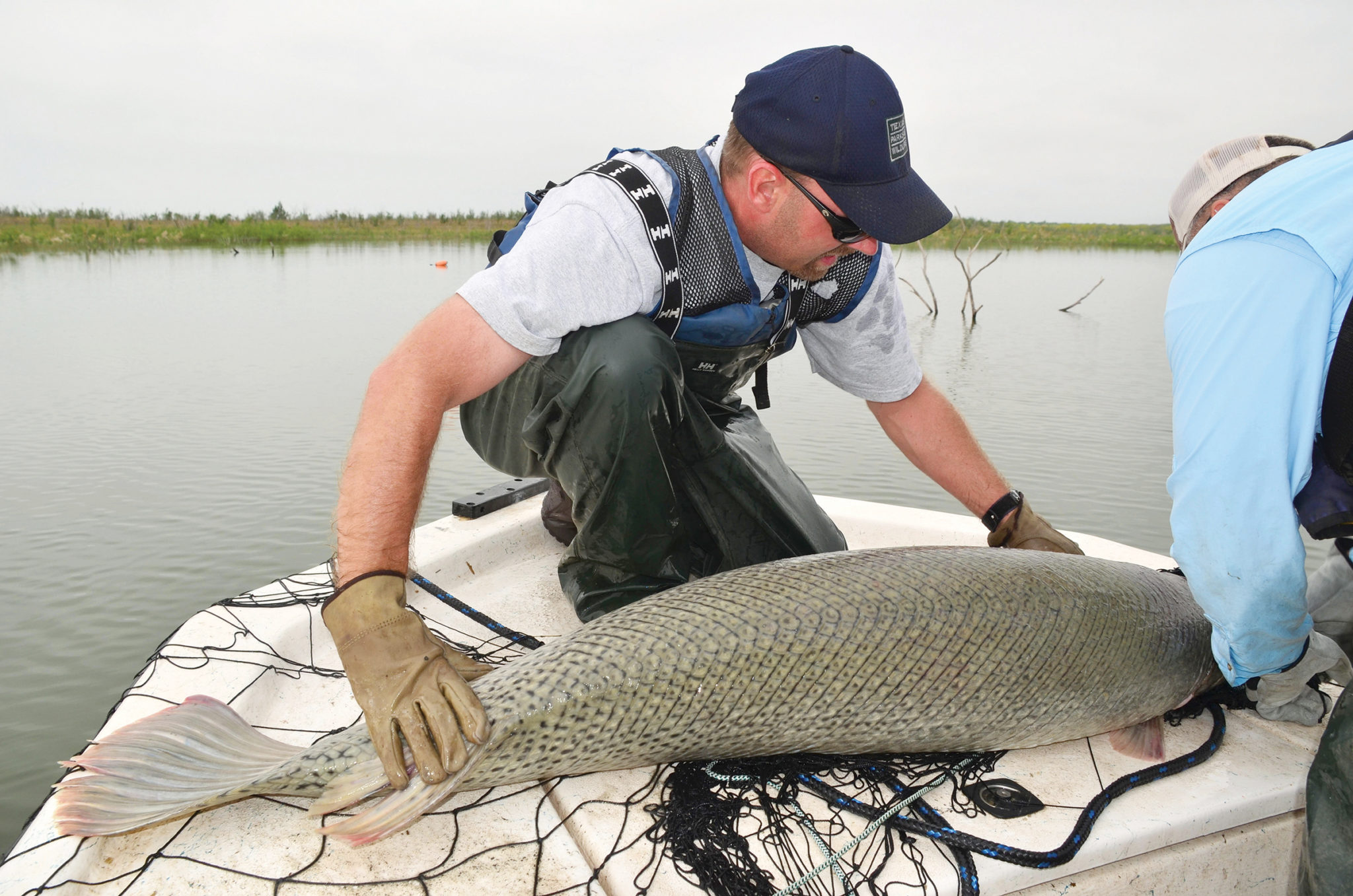
Most important was gaining an understanding of how gar live. “Their life history is more like a human’s than most other fish,” Daugherty said. They can live as long as 100 years, growing a few inches a year until they die, and spawning only during flood pulses that jump the riverbanks and spread out across nearby fields. During spawning, Daugherty has waded out and found himself surrounded by ripples of water and flashing fins, huge females twining through the grass, flanked by groups of smaller males, all of them moving with single-minded purpose. These spawning events are rarer than ever. The dam-building projects throughout the 20th century regulated flooding and tamed rivers, with disastrous results for breeding. While climate change may have led to more flooding in some places, it’s also likely to lead to a good deal more drought, too. The fish is now in a pattern of boom and bust, able to take advantage on the rare occasion of a big flood, but otherwise out of luck.
“What we’ve seen — so far, anyway — is that these flooding events have to be pretty large and long-lasting for them to actually breed, and it has to happen between April and July,” Daugherty said. “2015 was a banner year for them. We had huge year classes. 2017, we had no flood pulses, we didn’t find a single alligator gar spawn.”
The results of the fieldwork painted a troubling picture: a species that grew slowly, spawned rarely and was widely disliked by a large segment of the populace that knows of its existence.
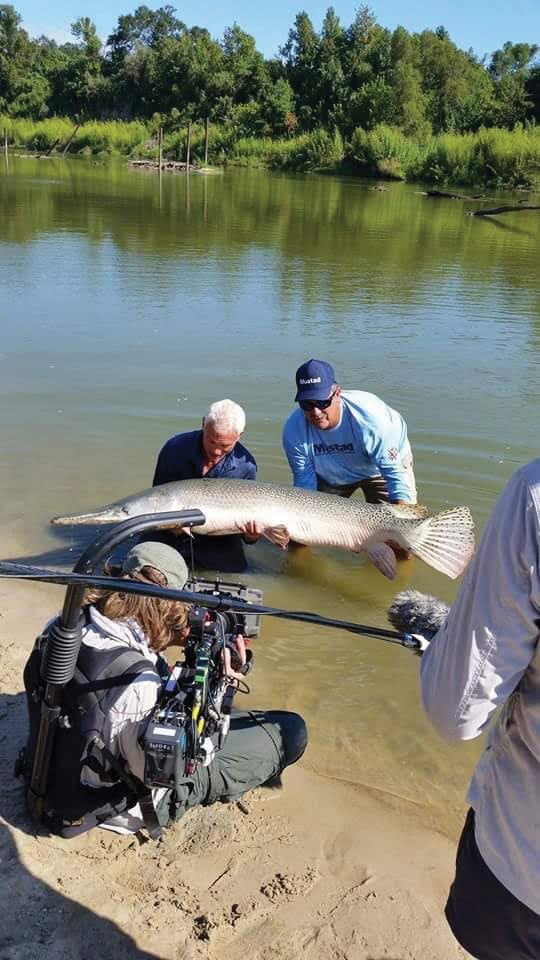
Yet the gar’s public reputation was changing. In 2009, TPWD set a one-per-day bag limit on alligator gar, in part thanks to pressure from guides. Recreational fishermen became notably friendlier to gar than commercial fishermen, seeing in them an opportunity for ongoing profit. The publicity of shows like River Monsters contributed as well. And TPWD has been tireless in getting the information out there, Daugherty says: A Facebook Live event he participated in earlier this year spread the good word to more than 50,000 people. TPWD launched a major publicity push and survey over the summer to suss out Texan attitudes and hunting practices around the fish; some 8,600 people responded. There seems to be a generational change at work, with even bowfishers like Bedre switching to catch-and-release line fishing with little complaint.
“Who would have thought the lowly alligator gar would have ever spawned such interest?” guide Kirk Kirkland said. “It’s amazing that anybody would ever have wanted to do a show for ’em, much less 46 shows and magazines. It’s incredible. I never in my lifetime would have thought that I’d go from catching these fish 50 days a year to 200 days a year.” While he is clear-eyed about the economic incentives behind protecting the fish, Kirkland also sees current regulations as insufficient. “I think we should push for one a year,” he said. “That, to me, is enough fish. You find a fish that’s 50, 60 years old, you don’t need to kill one a day. I think we’re moving toward more regulation.”
There’s something fairly simple at the root of the alligator gar’s appeal, Bedre says. They’re huge and strange, the sort of fish that looks like a fossil come to life, like a creature hauled up out of some backwater black lagoon to amaze and astound the world. “You can actually step back in time and see something that lived millions of years ago, unchanged,” he says. “That’s what’s so unique about them. Plus, they’re just fun to catch. Some of ’em like to fight. Some, it’s like pulling in a big log or stick. Some of ’em let you hold ’em, some of ’em don’t. You just don’t ever know what you’ve got till you get it into the boat.”
We hauled several gar into the boat over the course of the day, pulling them out of nets strung across the slow currents of the Brazos. The heat grew with the light, pressing down on us as we followed the bending course of the river, puttering past banks lined by silent cows and white flocks of egrets wheeling against the blue sky. None of the fish we brought into the boat attempted to bite; instead they thrashed occasionally, churned up a yellow foam of slime on the corrugated deck. Daugherty and Waldrep took turns levering open their jaws with fishhooks to free the netting, before performing the quick ritual of measurement, tagging and release. Some gar bore the indignity in stoic stillness; one 3 1/2-foot fish flopped until it bit down on a stray towel, after which it calmed like a child holding a safety blanket. It writhed in my hands as I slipped it overboard, its scales sharp and slick even through the gloves.
We stopped on a broad swath of brown water bordering a submerged limestone shelf. The boat surged back and forth along the river, engine moaning, stirring up a sloshing wake. Then we waited. For a time, nothing. Then over near the bank the water churned, buoys bucking and trembling.
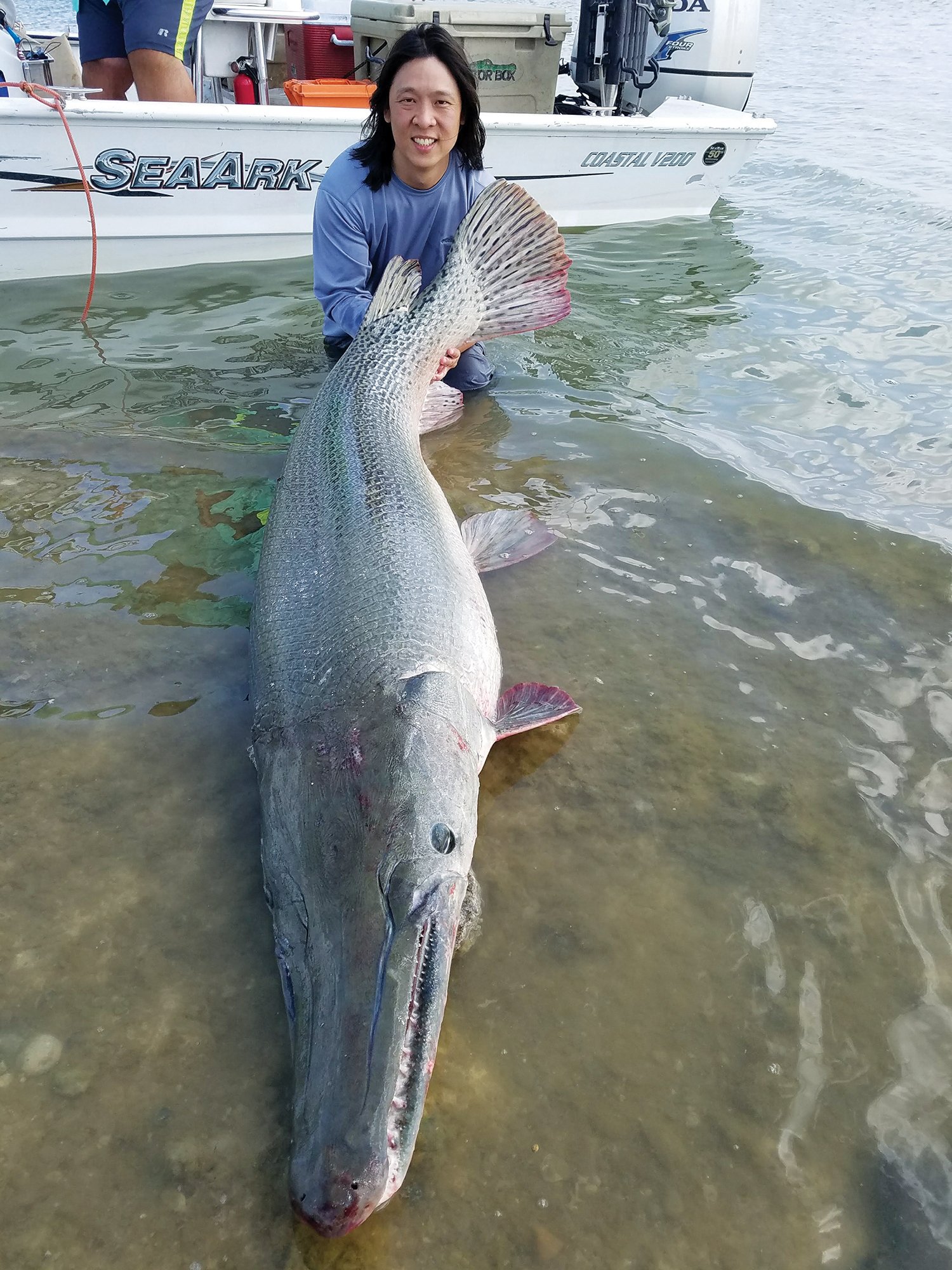
Daugherty piloted the boat close, with Waldrep already perched at the bow, waiting. The net surged away as we approached, something huge and powerful struggling beneath the surface. As Daugherty and Waldrep drew the nets in, the boat clanged under a fierce blow, water sloshing over the gunnels. It took three tries for the sweating, cursing men to haul the huge thing over the side. It flopped into the boat, a 7 1/2-foot female gar, 60 years old, perhaps older, and not yet finished growing. At first she wriggled, the boat shaking, metal ringing under the blows. A trickle of blood ran from the plates of her skull where she had rammed the side in her panic. Then she calmed.
I held my foot on her back, feeling the strength of the thing beneath my shoe, as Waldrep cut away the net and the team set about measuring and chipping. Her head rose in a disturbingly reptilian manner, her great jaws opening in a hissing breath. Bubbles formed along her gills. Her bulbous eyes retreated for a moment within the armored hulk of her skull. And then she quieted and laid still, watching us. Standing there with her, I was struck by a powerful sense of dislocation. She didn’t seem like a fish so much as something old and grand and forgotten, a spirit hauled up into a world seemingly ready to leave such things behind.
But she was real, down there beneath my shoe. And the boat seemed emptier without her when we slipped her back into the river and made for shore.

